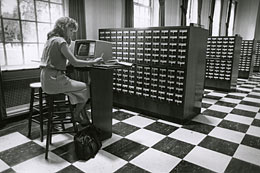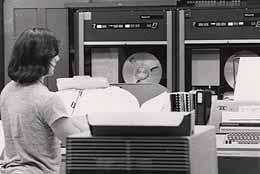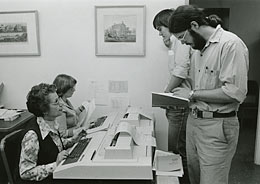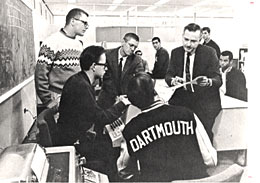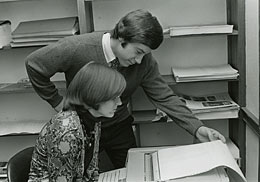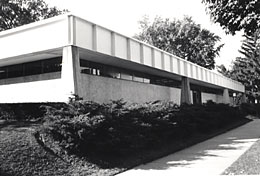The 1970s
1970
Text Editing Language Developed
Kiewit Machine Room: John G. Kemeny, Thomas E. Kurtz, Dr. Donald Shell (GE), Leonard Rieser, W. Derrick Johnston (GE)
The first opportunity to use DTSS effectively for text processing emerged when Thomas Takaro '72 developed a "new editing language called TEXT, very simple and easy to use."
Text Editing Language Developed
The first opportunity to use DTSS effectively for text processing emerged when Thomas Takaro '72 developed a "new editing language called TEXT, very simple and easy to use."
|
1971
Jury Apportionment System Developed
Thomas Kurtz wrote a program in BASIC that helped New Hampshire officials in the Grafton, Carroll, and Coos counties determine the apportionment of petit and grand jurors for the next 10 years. Naval Academy Installed DTSS
The U.S. Naval Academy at Annapolis became the first institution outside of Dartmouth to install DTSS software. Vice Admiral James Calvert, superintendent of the Academy, had visited all major educational time-sharing facilities in the nation before selecting DTSS. Move to Standardize BASIC
Dartmouth joined Hatfield Polytechnic in England to develop a formal definition of the BASIC language. The aim was to "avoid divergent interpretations of the language by future implementors. BASIC had rapidly gained popularity all over the world because of its simplicity and ease of use." (Data Processing Digest, Los Angeles, California, February 1971)
DTSS Tax App Developed
DTSS users could prepare their 1970 Income Tax Form 1040 and "Schedule A" by using a DTSS program called INCTAX-I. Project COMPUTe Launched
Project COMPUTe began as a three-year effort to support "writing and publication of course materials that would support educational use of computing in the undergraduate curriculum." Thomas E. Kurtz was the principal investigator and Professor Arthur Luehrmann was the project director. Funding was made possible by the National Science Foundation. Conference on Computers in the Curriculum
Dartmouth was host to the "Second Annual Conference on Computers in the Undergraduate Curriculum (CCUC)." Seventy scholarly papers were presented at the conference, and every registrant was given a complimentary User Number for accessing DTSS from public terminals in Kiewit and elsewhere on campus. Kiewit Part of New Cancer Center
Congress approved a $3,000,000 grant to fund the construction of the East's first regional cancer research and treatment facility at the Dartmouth Hitchcock Medical Center. The center would feature the third 45-million volt Brown-Boveri Betatron in the world. According to Dr. Frank Lane, director of the center, "one of the most important elements of the new Cancer Research and Treatment Center lies in the College's Kiewit Computation Center." The computer was used to "prepare treatment plans and radiation dosages for cancer patients in a matter of minutes." The Center was eventually named for Senator Norris Cotton of Lebanon, New Hampshire. See Norris Cotton Cancer Center. Dartmouth Educational Network Launched
The Dartmouth Educational Network became international when three phone lines were installed in Montreal to bring DTSS services to Canadian "educational institutions, educational research facilities, medical education and medical research institutions, government departments, research facilities for the advancement of the arts and sciences, etc." According to Thomas Kurtz, the extension of Dartmouth's network into Canada "combined the dreams of two Dartmouth presidents: former President John Sloan Dickey was a long-time advocate of closer Canadian-American cooperation. President Kemeny was a leader in supplying, through time-sharing, computing to liberal arts and business students." First Terminal Cluster in Baker
The first Kiewit terminal cluster was installed in Baker Library. The OCLC project was initiated to allow for automated preparation of catalog entries for new acquisitions using a dedicated phone line from Hanover to the OCLC offices in Columbus, Ohio. |
1972
Frost Collection Digitized
"A Concordance to the Poetry of Robert Frost," edited by Edward Connery Lathem, librarian of Dartmouth College, was produced with the aid of the College's Kiewit Computation Center. President John G. Kemeny supervised the planning and programming of the computer project that involved "the largest body of data ever stored by the Dartmouth computer for a single project." (The Dartmouth, 1/26/72) Project Conduit Funded
The National Science Foundation granted Dartmouth, the University of Texas, Oregon State University, the North Carolina Educational Computing Services Center, and the University of Iowa a total of $450,000 to participate in Project Conduit. The goal of the project was to "provide reliable information about programs and related course materials at several institutions, and to test the mechanics of moving programs from one computing system to another." Library Acquisition System Operational
Dartmouth reported that the new automated acquisition system in the Library was fully operational and had been successfully networked with the computer facilities of the Kiewit Computation Center. (Portsmouth Herald, 7/15/72) See Dartmouth College Library. General Electric Honored
A plaque honoring the contributions of the General Electric (GE) company to the development of time sharing at Dartmouth was unveiled. The ceremony recognized the completion of a six-year joint effort by Dartmouth College and General Electric, during which GE contributed more than $3,000,000 worth of computer equipment.
DTSS Uptime Was at 99.53 Percent
The Performance Report for September 1972 showed that DTSS was up 99.53 percent of scheduled operating hours; that nearly 20,000 hours were logged at terminals throughout the network; and that 313,258 jobs were processed during the month. The maximum number of simultaneous users observed was 113, and the average user load was 88.98. Tuck System Upgraded
Tuck School students were pleased to hear that the CRIII (Computer Research Involving Investment Information) system at Tuck had been replaced by a newer, more versatile program, LAFFF (Language for the Aid of Financial Fact Finders). DTSS IncorporatedDTSS Incorporated, a taxable corporation wholly owned by the Trustees of Dartmouth College, was formed to market DTSS software to educational and commercial organizations. Officers of the corporation were Rodney Morgan, president; Robert F. Hargraves, executive vice president; Thomas E. Kurtz, director; Thomas E. Byrne, treasurer and director; W. Leslie Peat, secretary and director; John S. McGeachie, director; and Donald L. Krieder, director. Project FIND Developed
Project FIND (Forecasting Institutional Needs at Dartmouth) was developed on the Dartmouth Time-Sharing System "to make information about the College readily available to department heads, faculty, administrators, and trustees." John S. McGeachie was director of the project that was funded in part by a $200,000 gift from the Rockefeller Brothers' Foundation. Planned uses of the system included "maintenance and analysis of data on alumni giving, students, and budgeting for the College." (Note: In January 1990, FIND databases continued to provide information essential to the management of the College.) COM Series Catalog Implemented
A COM (Computer Operated Microfiche) serials catalog was implemented by the Library. |
1973
Course Change Fee Waived
Dartmouth undergraduates saved money and time as course changes were processed using terminals on the Dartmouth Time-Sharing System. Under the old manual system, students would have paid over $12,250 ($5.00 each for 2,450 course changes). Under the computerized system, the fee was waived and changes were processed at a cost to the College of about five cents each. MRDF Database Proposed
A faculty committee proposed that the Dartmouth libraries develop a database of Machine Readable Data Files (MRDFs). Kemeny Keynote Speaker at EDUCOM
John G. Kemeny was the keynote speaker at the April 6, 1973, EDUCOM conference on "Planning for National Networks." Thomas E. Kurtz served as chairman of a panel discussion on "Regional Networks as a Basis for National Nets." Educational Network Expanded
Dartmouth installed eight phone lines throughout New England and New York State dedicated to providing access to the Dartmouth Educational Network on a local call basis for hundreds of high schools, colleges, not-for-profit research organizations, and individuals in the Northeast. Libri Project Underway
The Libri Project amassed a collection of literary texts in computer-usable form available to any interested users of the Dartmouth system. With the cooperation of Edward C. Lathem, Dartmouth College librarian, the poems of Robert Frost, T. S. Elliot, and Rupert Brooke were included on the list. Milton's Paradise Lost and 200,000 lines of texts ranging from Homer's Illiad and Odyssey, through the New Testament in Greek, and from Plautus to Boethius in Latin were also made available as electronic texts. Dynamo Compiler Rebuilt
Philip Koch '70 and Chip Elliot '76 developed a machine-language compiler version of the simulation language DYNAMO to replace the old BASIC version. Chess Program in Tournament
Dartmouth's DTSS Chess program finished in a three-way tie for fifth place in the Fourth Annual A.C.M. Computer Chess Championship. The highlight of the tournament was Dartmouth's draw with four-year undefeated tournament champions Northwestern. The program was written primarily by Warren Montgomery '73 in cooperation with Larry Harris, a professor in mathematics. |
1974
Computers in Classroom Conference Opened
On January 24-25, Kiewit and CONDUIT sponsored an on-campus conference on the "Use of Computational Methods in All Aspects of Classroom Instruction." The sessions were open to all, and faculty members were encouraged to bring students. Speakers and topics included:
Grumman Installed DTSS
Grumman Data Systems installed the first commercial version of the DTSS operating system at its data center in Bethpage, Long Island, New York. According to Curt DeForrest, vice president of network services, "The Dartmouth system is a logical extension for Grumman. The system is extremely attractive to commercial, as well as educational, users due to its comparative ease of use, easy access, fast response time, excellent security, online database systems, and low cost." The system was licensed to Grumman through Dartmouth's subsidiary, DTSS, Incorporated. (March 1, 1974) Pioneer's Day Featured Stibitz
Pioneer's Day at the National Computer Conference in Chicago (May 6-10, 1974) featured a tenth anniversary tribute to Dartmouth and its pioneering role in time sharing. George Stibitz of Dartmouth was introduced as the "1965 Harry Goode Medalist" for his work in remote computing in the 1940s. The history of BASIC was reviewed, revealing that in 10 years, the BASIC manual had grown from a 14-page booklet that included 15 statements, to a 175-page book describing 36 statements.
Conference on Graphics and BASIC Held
A "Working Conference on Graphics in BASIC" was held at the Minary Center at Squam Lake. Sponsored in part by CalComp, Hewlett-Packard, and Tektronix, the conference featured 21 experts from education and business discussing the merits and desired characteristics of graphical capabilities for BASIC. |
1975
McGeachie, Kurtz Appointed to Positions
Thomas E. Kurtz was appointed the first director of Academic Computing by President John G. Kemeny, while John S. McGeachie '65 was appointed the director of Computing Services. McGeachie, former director of Data Processing at Dartmouth, had made significant contributions to the development of the Dartmouth Time-Sharing System as one of the first students to work with Kemeny and Kurtz on the design of DTSS "executive programs." Dartmouth Plan Facilitated by Kiewit
Year-round operation under the Dartmouth Plan increased administrator's dependence on the Kiewit Computation Center. Director of Computing Services John McGeachie reported that since 1971 more than a half-dozen major administrative programs have been put on the DTSS computer. The Registrar's Office and the Housing Office became major users of time sharing. (The Dartmouth, May 5, 1975) Daily Dartmouth on Usage
The Daily Dartmouth reported that administrators used 28 percent of time-sharing resources, while students used 20 percent. Computing in Instructional Process
John Nevison reported the results of a survey of faculty and student use of computing in the instructional process. Eighty-three percent of the faculty were contacted directly. The results:
Peter Kiewit '22 and Wife Evelyn Made Major Donation
Peter Kiewit '22 and his wife Evelyn donated $500,000 to Dartmouth for the acquisition of a new Honeywell 66/40 computer.
Library Catalog Project Proposed
A Computer Operated Microfiche (COM) catalog was proposed for the libraries. |
1976
Conference Aimed to Demystify Computers
Over 200 women administrators from around the country attended a conference at Dartmouth on "The Administrative Use of the Computer in Education" aimed at demystifying the computer. Man and the Computer
A symposium entitled "Man and the Computer" was held to celebrate the 10th anniversary of the Kiewit Computation Center. Computer experts from business, government, and education met to discuss such topics as privacy, the computer and the law, computer crime, The Cashless Society, and the multi-national computer. John G. Kemeny, whose book inspired the title for the conference, was the keynote speaker. Kiewit Rededicated
On December 1, a formal rededication and recognition ceremony was held at Kiewit. Peter and Evelyn Kiewit were present to witness the unveiling of a commemorative plaque recognizing their support of computing. Hal Franklin '76 presented Peter Kiewit with an honorary Kiewit t-shirt with User Number K00001 emblazoned on the back. John S. McGeachie awarded Thomas E. Kurtz a plaque recognizing his years of leadership at Kiewit.
|
1977
Alumni Offered Minicourse
Dartmouth alumni returning to Hanover for reunions in June were offered a two-day minicourse on computing. Arlene Larsen taught a session entitled, "You Too Can Play the Computer." Math Offered Concentration in Computer Science
Dartmouth allowed math majors to obtain a specialized major with concentration in computer science. Incident Shuts Down Kiewit
Thirteen thousand volts passed through the body of a small squirrel at 6:40 a.m. on June 30, 1977, and shut down Kiewit for 10 hours. |
1978
Arms Appointed Director
Dr. William Y. Arms was appointed director of Computing Services, succeeding John S. McGeachie, who left the College to assume an executive position in business. Arms was an Oxford graduate with an M.S. degree from the London School of Economics, and a doctorate from Sussex University. As a member of the faculty of the British Open University, he wrote a dissertation on "Interlibrary Lending and the Use of the Computer." Thomas E. Byrne served as acting director until Arms arrived on campus. Computing History Recounted
A "History of Dartmouth Computers" was published in Kiewit Comments. Highlights:
Energy models on DTSS made by the Dartmouth System Dynamics Group at the Thayer School of Engineering were obtained by the U.S. Department of Energy to determine federal energy policies for research across the nation. Two large computer models of energy resources (Fossil1 and Coal1) were used to study "the effects of resource depletion and of changing supply-demand pressures on the availability, price, and distribution of energy types." Dr. Roger Naill directed the project and was named director of a long-term policy design office in the Department of Energy. DTSS Sold to Met Life
DTSS Incorporated, the company that sold DTSS software and related services, was sold to the Metropolitan Life Insurance Company.
Online Library Catalog Proposed
The Committee on the Future of the Card Catalog rejected the COM catalog, and instead proposed a pilot project for an online catalog using Bibliographic Retrieval Services (BRS) software.
CBS Interviewed at Dartmouth College
Dartmouth professors Roger Masters, Michael Carter, and Jon Appleton and senior Lissa Miller were featured on CBS television's Morning News program. In the interview, President Kemeny stressed "that within the next generation, computers will have a fundamental impact on the life of mankind — either for the better or for the worse. And the more students understand about this, the more likely the impact will be favorable... It is much too dangerous to let another generation come out of our colleges as computer illiterates. Because then a small number of computer experts will make decisions for us as to how computers will be used and that's much too dangerous." |
1979
President Ford Presented Award
Dartmouth was one of 12 institutions (out of 275 nominees) to be recognized for their "leadership in raising educational effectiveness including the advanced applications of computer technology for learning as well as management." Former President Gerald R. Ford presented $10,000 and a certificate to the College on behalf of the Academy for Educational Development. Peter Kiewit Died, Left $1 Million Gift
Peter Kiewit, a long-time benefactor and friend of computing at Dartmouth, died on November 2, 1979. In Kiewit's words, "the opportunity to help with this important work" (in computing) had been "one of the deepest sources of gratitude" in his life, and the life of his first wife, Evelyn. It was later announced that Kiewit would leave $1,000,000 to Dartmouth for the expansion and operation of the Kiewit Computation Center.
Prime 650 Acquired
The PRIME 650 computer was introduced to the Dartmouth community as "the new kid on the block." Computing Services, Tuck School, and the Chemistry Department combined resources to purchase the number-crunching computer to be used for research computing. Computer Science Masters Program Announced
Dartmouth announced plans to institute a Master's Degree in Computer and Information Science in the fall of 1980. IBM granted $500,000 to get the program started. Twenty students were expected in 1980, and 40 in 1981. (Computerworld, 7/16/79.) See Dartmouth Computer Science. Online Catalog Project Hired Director
Emily Fayen was hired to direct the BRS online catalog pilot project.
BELLVUE Introduced
Elisha Huggins, director of Dartmouth's NSF-sponsored CAUSE (Comprehensive Assistance to Undergraduate Science Education) program, demonstrated the use of a New England Digital ABLE computer at the "First National Conference on Computers in Under-graduate Education." With the goal of bringing minicomputers into the College laboratory, a small computer named BELLVUE (Buses Engaged in Lightening the Load of Valuable but Underpaid Educators) was introduced to five departments to give students and faculty "a cheaper, more reliable, and much more flexible computer system" for the laboratory. The BELLVUE evolved to the New England Digital ABLE and led to the formation of The New England Digital Company (established, among others, by Sydney Alonso, formerly of Thayer School, and Cameron Jones '74, developers of BELLVUE); the development of the famous Synclavier used by Michael Jackson and other famous rock groups and performers; and the development of the New England Digital Node controllers used throughout the Dartmouth time sharing network.
|













